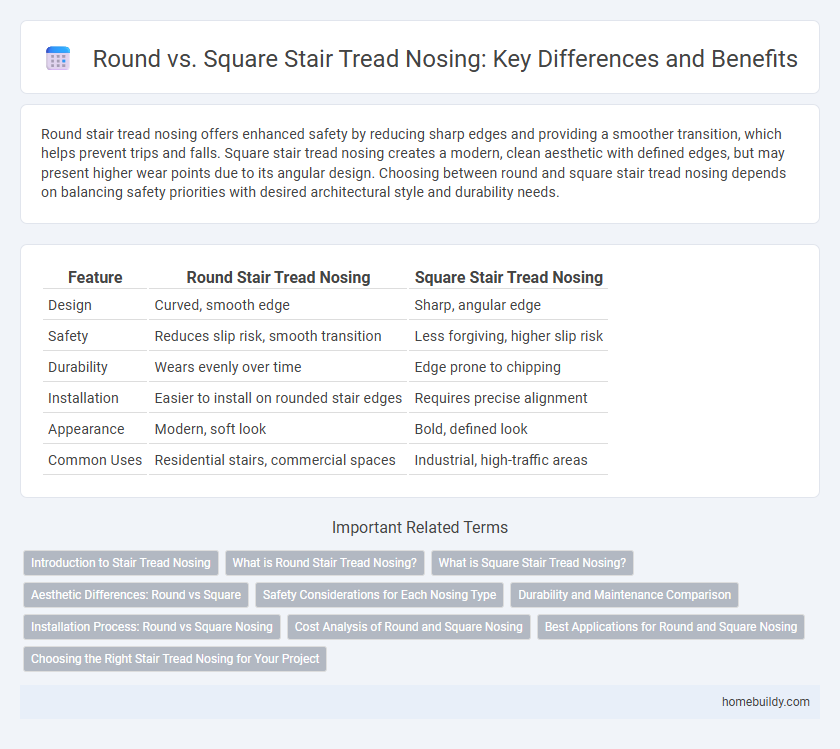Round stair tread nosing offers enhanced safety by reducing sharp edges and providing a smoother transition, which helps prevent trips and falls. Square stair tread nosing creates a modern, clean aesthetic with defined edges, but may present higher wear points due to its angular design. Choosing between round and square stair tread nosing depends on balancing safety priorities with desired architectural style and durability needs.
Table of Comparison
| Feature | Round Stair Tread Nosing | Square Stair Tread Nosing |
|---|---|---|
| Design | Curved, smooth edge | Sharp, angular edge |
| Safety | Reduces slip risk, smooth transition | Less forgiving, higher slip risk |
| Durability | Wears evenly over time | Edge prone to chipping |
| Installation | Easier to install on rounded stair edges | Requires precise alignment |
| Appearance | Modern, soft look | Bold, defined look |
| Common Uses | Residential stairs, commercial spaces | Industrial, high-traffic areas |
Introduction to Stair Tread Nosing
Stair tread nosing enhances safety and durability by providing a visible edge and increased grip on stair steps. Round stair tread nosing offers a softer, curved profile that reduces wear and minimizes tripping hazards, while square stair tread nosing features a sharp, defined edge for a modern aesthetic and easier installation. Choosing between round and square nosing affects the stair's functionality, maintenance, and overall design appeal.
What is Round Stair Tread Nosing?
Round stair tread nosing features a curved edge designed to enhance safety by reducing sharp corners and providing a smooth surface that minimizes trips and falls. This type of nosing improves durability by evenly distributing foot traffic impact, making it ideal for high-use staircases. Round nosing also contributes to aesthetic appeal by offering a softer, more finished look compared to square options.
What is Square Stair Tread Nosing?
Square stair tread nosing is a type of stair edge profile characterized by a straight, right-angled edge that provides a clean and modern look while enhancing safety by offering a clear demarcation of stair edges. This design is commonly made from durable materials such as aluminum, wood, or PVC, ensuring longevity and slip resistance in high-traffic areas. Square stair tread nosing also facilitates easier installation and maintenance compared to rounded alternatives, making it a practical choice for both commercial and residential staircases.
Aesthetic Differences: Round vs Square
Round stair tread nosing offers a softer, more traditional aesthetic that enhances the flow of a staircase with its smooth, curved edges, often creating a welcoming and classic look. Square stair tread nosing provides a clean, modern appearance with sharp, defined lines that emphasize architectural precision and contemporary design. Selecting between round and square nosing significantly impacts the overall visual style, influencing whether a space feels warm and inviting or sleek and minimalistic.
Safety Considerations for Each Nosing Type
Round stair tread nosing offers enhanced safety by reducing sharp edges, minimizing the risk of trips and falls, especially in high-traffic areas. Square stair tread nosing provides a defined edge that can improve visibility of stair steps, aiding users with visual impairments. Both types must comply with building codes and standards to ensure slip resistance and durability, tailored to specific environmental and usage demands.
Durability and Maintenance Comparison
Round stair tread nosing offers enhanced durability by distributing impact forces more evenly, reducing wear and extending lifespan compared to square nosing. Square stair tread nosing tends to accumulate dirt and debris in its sharp edges, requiring more frequent cleaning and maintenance efforts. Maintenance for round nosing is generally easier as its curved surface minimizes grime buildup and simplifies routine upkeep.
Installation Process: Round vs Square Nosing
Round stair tread nosing typically requires more precise cutting and shaping techniques to achieve a smooth, curved edge, demanding specialized tools for proper fitting. Square stair tread nosing features straightforward, right-angled edges that simplify the installation process and reduce preparation time. Both types require secure fastening and alignment, but square nosing often allows for quicker installation due to its simpler profile and less complex finishing work.
Cost Analysis of Round and Square Nosing
Round stair tread nosing typically incurs higher material and installation costs due to the specialized manufacturing processes and custom fitting required for curved edges. Square stair tread nosing is generally more cost-effective, benefiting from straightforward production and easier installation with standard materials. Comparing long-term maintenance expenses, round nosing may also lead to slightly increased costs because of its susceptibility to wear on the curved surfaces, while square nosing tends to maintain its structural integrity longer with minimal upkeep.
Best Applications for Round and Square Nosing
Round stair tread nosing offers superior slip resistance and enhanced safety, making it ideal for high-traffic commercial areas and public buildings. Square stair tread nosing provides a sleek, modern aesthetic suitable for residential spaces and contemporary architectural designs. Choosing between round and square nosing depends on durability requirements and design preferences, with round nosing excelling in safety-critical environments and square nosing enhancing visual appeal.
Choosing the Right Stair Tread Nosing for Your Project
Round stair tread nosing offers enhanced safety by reducing sharp edges, making it ideal for high-traffic areas where slip resistance is critical. Square stair tread nosing provides a clean, modern aesthetic with a defined edge, suitable for contemporary architectural designs requiring precise lines. Selecting the right stair tread nosing depends on factors such as foot traffic, design preferences, and compliance with safety codes to ensure durability and user safety.
Round stair tread nosing vs square stair tread nosing Infographic

 homebuildy.com
homebuildy.com